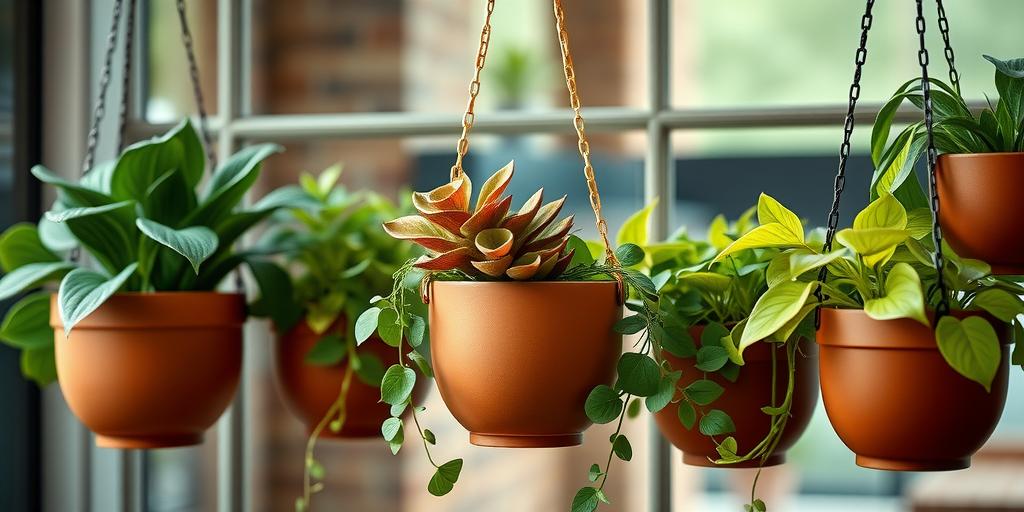
Eco-Friendly Hanging Planters Perfect for Low Light Plants (2025)
Discover the best eco-friendly hanging planters for low-light plants! From sustainable materials to stylish designs, find the perfect planter to brighten up your space—even in dim corners.
Introduction
Did you know that low-light plants can thrive even in the shadiest corners of your home? But here’s the catch—they need the right environment, and that starts with the perfect planter! If you’re looking for sustainable ways to display your greenery, eco-friendly hanging planters are the way to go. Not only do they save space, but they also add a touch of nature to your home without harming the planet.
Why Choose Eco-Friendly Hanging Planters?
Benefits of Sustainable Materials (Bamboo, Recycled Plastics, Cork)
Eco-friendly hanging planters are made from materials that don’t harm the planet. Bamboo, for example, grows quickly and is naturally sturdy, making it a great renewable resource. Recycled plastics give a second life to waste that would otherwise sit in landfills, while cork is harvested without harming trees and is naturally moisture-resistant. These materials aren’t just good for the Earth—they’re also built to last.
Reduced Environmental Impact Compared to Traditional Planters
Conventional planters often use materials like non-recycled plastic or chemically treated ceramics, which take a toll on the environment. Eco-friendly alternatives minimize pollution and resource depletion. Plus, many sustainable planters are biodegradable or recyclable at the end of their lifespan, so they won’t contribute to long-term waste.
Lightweight Yet Durable Designs for Easy Hanging
Nobody wants a heavy, clunky planter that’s hard to install. Sustainable materials like cork and bamboo are naturally lightweight, making them easy to hang without sacrificing durability. Even recycled plastic options are designed to be sturdy while remaining easy to move or adjust as needed.
Aesthetic Appeal—Blending Nature with Modern Decor
Eco-friendly doesn’t mean sacrificing style. Bamboo planters bring a natural, earthy feel, while sleek recycled plastic designs fit seamlessly into modern spaces. Macramé hangers add a boho touch, and cork planters offer a minimalist, organic look. No matter your decor style, there’s an eco-friendly hanging planter that complements it.
Best Materials for Eco-Friendly Hanging Planters
Bamboo: Naturally Sturdy and Biodegradable
Bamboo is one of the best materials for sustainable planters because it grows rapidly, requires little water, and is naturally strong. It’s also biodegradable, so when it eventually wears out, it won’t linger in a landfill for centuries. Bamboo planters work well indoors and outdoors, offering a timeless, natural aesthetic.
Recycled Plastic: Durable and Reduces Waste
Recycled plastic planters give discarded materials a new purpose. They’re tough, weather-resistant, and ideal for both indoor and outdoor use. Since they’re made from post-consumer waste, they help reduce plastic pollution while still providing a long-lasting home for your plants.
Cork: Lightweight and Moisture-Resistant
Cork is harvested from the bark of cork oak trees without harming them, making it a renewable resource. It’s naturally resistant to moisture, which helps prevent mold and rot—perfect for hanging planters. Plus, its soft texture and neutral color make it a stylish addition to any space.
Macramé (Organic Cotton): Stylish and Compostable
For a softer, bohemian look, macramé hangers made from organic cotton are a great choice. They’re compostable at the end of their life and add a cozy, handmade feel to your decor. Pair them with a small pot inside for an effortlessly chic hanging display.
Terracotta: Breathable and Classic
Terracotta is a traditional favorite for a reason—it’s porous, allowing roots to breathe, and it’s made from natural clay. While not always considered “eco-friendly” due to the energy used in firing, untreated terracotta is still a better choice than synthetic alternatives since it’s biodegradable and chemical-free.
Top Low Light Plants for Hanging Planters
Pothos: Hardy and Adaptable
Pothos is a go-to for low-light environments because it thrives even in dim corners. Its trailing vines make it perfect for hanging planters, and it’s forgiving if you forget to water it now and then.
Spider Plant: Thrives in Indirect Light
Spider plants are nearly indestructible and do well in indirect sunlight. They produce “pups” (baby plants) that dangle from the mother plant, creating a cascading effect that looks stunning in hanging setups.
Philodendron: Low-Maintenance and Lush
With heart-shaped leaves and a vining habit, philodendrons add a tropical touch to any space. They tolerate low light well and grow quickly, making them ideal for filling out a hanging planter.
ZZ Plant: Survives in Almost Any Light Condition
The ZZ plant is famously resilient—it can handle low light, infrequent watering, and even a bit of neglect. Its glossy leaves add a modern, polished look to hanging displays.
Ferns (e.g., Boston Fern): Love Humidity and Shade
Ferns, like the Boston fern, thrive in shady, humid spots, making them perfect for bathrooms or kitchens. Their feathery fronds spill beautifully over the edges of hanging planters, creating a lush, green cascade.
How to Style Eco-Friendly Hanging Planters in Your Home
Boho Chic: Macramé Hangers with Cascading Pothos
For a relaxed, bohemian vibe, pair organic cotton macramé hangers with trailing pothos or spider plants. The combination of textured rope and flowing greenery creates a cozy, nature-inspired look.
Minimalist: Sleek Bamboo Planters with ZZ Plants
If you prefer clean lines and simplicity, opt for sleek bamboo planters paired with structured plants like ZZ plants or snake plants. The natural wood tones keep the look warm while maintaining a modern aesthetic.
Urban Jungle: Mixed Hanging and Standing Plants for Depth
Create depth in your space by mixing hanging planters with standing ones. Use recycled plastic or cork planters for hanging varieties like philodendrons, and complement them with taller floor plants like fiddle leaf figs.
Kitchen Greens: Herb-Friendly Recycled Plastic Planters
Hang small recycled plastic planters near a kitchen window to grow herbs like basil, mint, or parsley. The durable material can handle moisture, and the convenience of having fresh herbs within reach is unbeatable.
DIY Eco-Friendly Hanging Planter Ideas
Upcycled Glass Jars with Rope Hangers
Turn old glass jars (like mason jars or pasta sauce containers) into hanging planters by wrapping them with jute rope or twine. Add drainage holes at the bottom, and you’ve got a charming, zero-waste planter.
Cork Planters for Small Succulents
Use wine corks (or larger cork sheets) to craft tiny planters for succulents or air plants. Cork’s natural moisture resistance makes it a great choice for these low-maintenance plants.
Handwoven Coconut Fiber Baskets
Coconut fiber (coir) is a sustainable material that can be woven into small baskets. Line them with moss or a biodegradable liner, and they become perfect little hanging homes for small plants.
Repurposed Tin Cans with Drainage Holes
Clean out old tin cans, punch drainage holes in the bottom, and paint or wrap them in fabric for a rustic-chic hanging planter. They’re especially great for herbs or small trailing plants.
Maintenance Tips for Hanging Low Light Plants
Watering Frequency (Less Is More for Low-Light Plants)
Low-light plants generally need less water because they grow slower and evaporate moisture less quickly. Always check the soil before watering—stick your finger in about an inch deep; if it’s dry, it’s time to water.
Proper Drainage to Prevent Root Rot
Even in hanging planters, drainage is key. Make sure your planter has holes at the bottom, or use a layer of pebbles to prevent water from pooling. Root rot is a common issue in plants that sit in soggy soil.
Dusting Leaves for Better Light Absorption
Dust can block the limited light that low-light plants receive. Wipe leaves gently with a damp cloth every few weeks to keep them clean and efficient at absorbing light.
Seasonal Care Adjustments
Plants may need different care in winter versus summer. In colder months, reduce watering frequency since plants grow slower. If humidity drops (especially with indoor heating), mist ferns or group plants together to create a more humid microclimate.
Conclusion
Eco-friendly hanging planters aren’t just good for your plants—they’re great for the planet too! By choosing sustainable materials and pairing them with low-light-loving greens, you can create a lush, stylish space without compromising on environmental values. Ready to transform your home? Pick your favorite planter, hang it up, and let nature do the rest!
